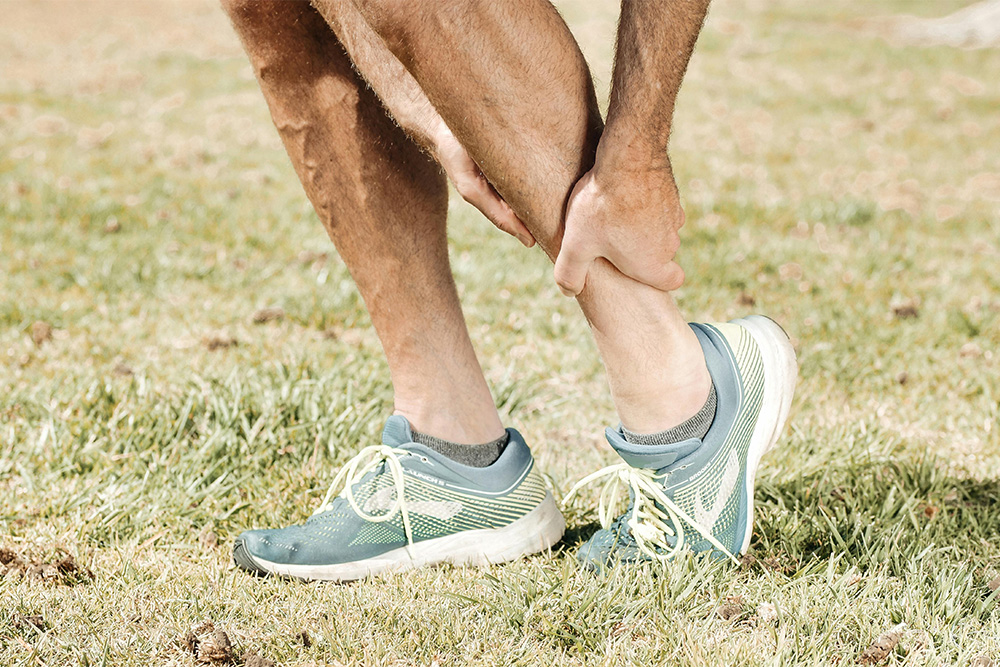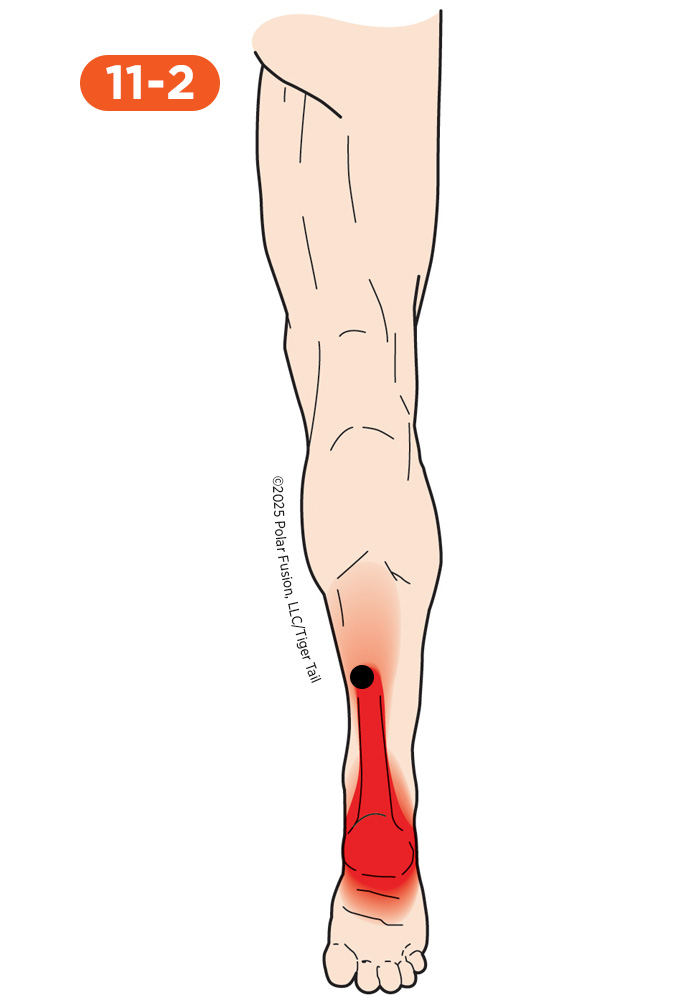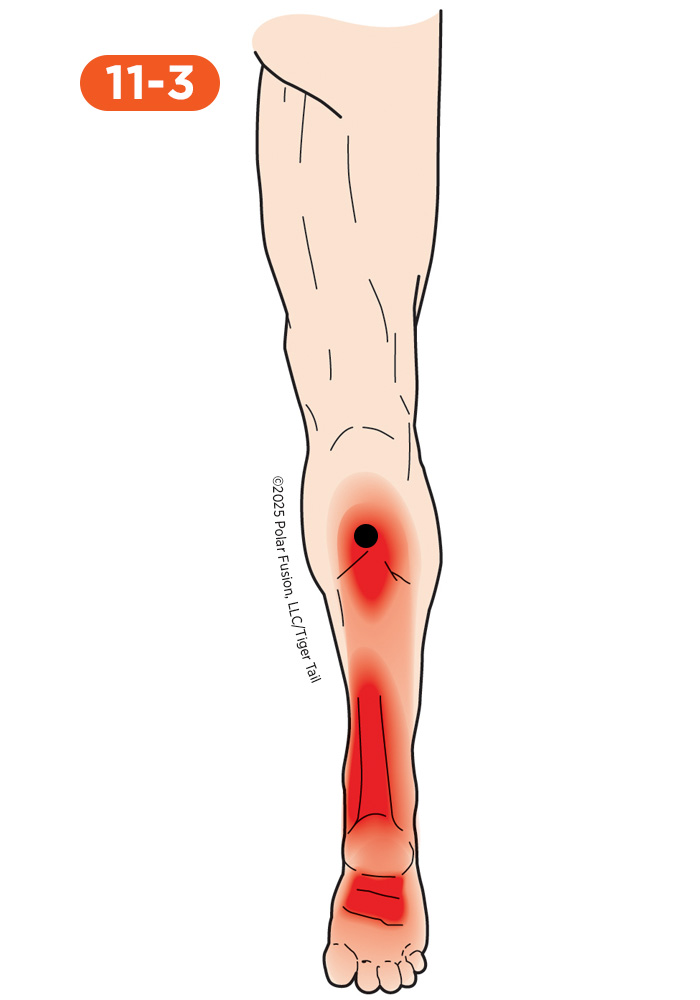Achilles Pain
Muscle knots in the calf muscles can lead to pain in the Achilles Tendon. Muscle knots in the Tibialis Posterior can cause pain directly above the heel bone or what is known as the Achilles Tendon. This pain or discomfort will also be felt in the sole and/or arch of the foot.

Causes
Running or walking on uneven surfaces: Walking or running on uneven surfaces can significantly contribute to ankle pain and instability. The constant micro-adjustments your calf muscles must make to maintain balance on uneven surfaces lead to their overuse and a higher likelihood of developing muscle knots. These muscle knots in overworked calf muscles can then contribute to instability, making you more prone to ankle rolls or sprains.
Wearing High Heels: Wearing high heels forces the calf muscles into a shortened, contracted position, making them highly susceptible to developing muscle knots. These tight knots, especially in the gastrocnemius and soleus, can then cause aching pain in the calves and even refer discomfort up into the Achilles tendon or down into the foot. Over time, this chronic shortening and muscle knot formation can lead to persistent calf pain, Achilles tightness, and general foot discomfort when not wearing heels.
Hyperpronation: Hyperpronation, or excessive inward rolling of the foot, places unnatural strain on the calf muscles, particularly the soleus, making them highly prone to developing restrictive muscle knots. These muscle knots in the overstretched and overworked calf muscles can then cause a deep ache along the inside of the lower leg and contribute to shin splints and plantar fasciitis due to altered biomechanics. This can also lead to chronic calf tightness and persistent lower leg pain, often felt as a nagging ache after activity.
Morton Foot Structure or Elevated First Metatarsal: Did you know that the shape of your foot can contribute to ankle pain? If you have a Morton’s foot, where your second toe is longer than your big toe, or an elevated first big toe (metatarsal), it can throw off your foot’s natural mechanics. This foot structure causes you to shift more weight onto the outer part of your foot and the second toe when you walk or run. Over time, your calf and ankle muscles have to work extra hard to keep you stable. This constant strain can lead to the development of painful muscle knots, which then become a source of chronic ankle pain and instability.

I Feel
Calf Cramps
You know those sudden, intense calf cramps that suddenly stop you in your tracks and make you grab your leg? They’re often caused by tight muscle knots and overuse of your calf muscle, the gastrocnemius. What you’ll experience is a sharp, seizing pain that suddenly grips your calf like a vice, and even after the cramp releases, you’re left with a deep, throbbing ache and tenderness that can last for days. You’ll really notice the cramps happening when you’re pointing your toes, swimming or doing water activities, running or exercising without proper warm-up, standing on your tiptoes, or when you’re dehydrated or fatigued. Here’s what makes this so frustrating – because the gastrocnemius can develop chronic trigger points from repetitive use, these cramps can easily mimic more serious issues like deep vein thrombosis, nerve compression, or circulation problems. If you press into the belly of your calf muscle (the meaty upper part), it will probably be extremely tender with hard, knotted areas you can feel, and your calf will feel tight and vulnerable.
Achilles Tendonitis
Persistent Achilles tendonitis pain may be caused by tight muscle knots in your calf muscle, specifically the gastrocnemius. You’ll notice a sharp, burning pain right where your calf meets your Achilles tendon, along with a deep, nagging ache that radiates down into the tendon and sometimes up into your calf. The pain often worsens when you’re running (especially sprinting or doing speedwork), jumping, walking uphill, going upstairs, or engaging in any activity that requires forcefully pushing off with your toes. When it’s tight and knotted, it creates constant tension on the tendon, which can easily mimic true Achilles Tendonitis, tendon tears, or insertional tendon problems at the heel. If you press into the upper part of your calf muscle, it will probably be very tender and tight, and your Achilles will feel stiff and restricted.
Pain on the Bottom of the Big Toe
When you’ve got mysterious pain on the bottom of your big toe, you probably wouldn’t think to look at your calf – but it might be referred pain coming from tight muscle knots in your gastrocnemius. You’ll feel is a deep, aching pain under your big toe joint that can feel like pressure or bruising, and it often travels from your heel forward into the ball of your foot and big toe area. You’ll really notice the pain getting worse when you’re walking barefoot on hard surfaces, pushing off to run or sprint, wearing high heels or shoes with elevated heels, doing calf raises, or standing on your tiptoes for extended periods. When it’s knotted up it can send pain all the way to your big toe, and it can easily mimic sesamoiditis, big toe joint arthritis, or turf toe. If you press into the meaty part of your calf muscle, it’ll probably be tender with tight bands running through it, and your big toe will feel stiff and painful.

I Feel
Jogger's Heel
That classic jogger’s heel—those deep, persistent aches right in your heel bone that every runner fears—are often caused by tight muscle knots in your deep calf muscle, the soleus. What you’ll experience is a deep, throbbing pain centered in your heel, accompanied by a dull, bruised feeling that resembles the sensation of pounding on concrete for hours. You’ll notice the pain worsens when you’re running, taking your first steps in the morning, standing for long periods, walking uphill, or doing any repetitive impact activities that load your heel. This can easily mimic plantar fasciitis, heel spurs, or stress fractures. If you press deep into your calf, it will likely be tender and dense with muscle knots, and your heel will feel guarded and sensitive—as if you can’t comfortably put your full weight down and are constantly favoring that foot.
Achilles Tendonitis
When you experience pain that closely resembles Achilles Tendonitis, the cause might be deep muscle knots in the underlying calf muscle, the soleus. The discomfort usually feels deep beneath the gastrocnemius and right at the heel bone, presenting as a dull, deep ache that can sometimes radiate along the bottom of the foot. It’s often at its worst first thing in the morning or after you’ve been resting for a bit, and then it can really flare up when you start moving around, especially if you’re doing activities like running or walking a lot. You may notice the pain worsens during endurance activities such as walking long distances, running uphill, or standing for hours (especially when your knee is slightly bent). Since the soleus attaches directly to the heel and constantly supports your body weight, these muscle knots can easily mimic more serious issues like true Achilles tendinopathy, plantar fasciitis, or a bone spur. The deep, inner calf tissue is often very sensitive to pressure, causing the heel to feel guarded and restricted, particularly during the push-off phase of walking.
Heel Pain
When you experience general heel pain, the cause is often deep muscle knots in the powerful, deep calf muscle called the Soleus. The discomfort usually centers deep within the heel bone, manifesting as a deep, throbbing ache that feels like a constant bruise. You’ll notice that the pain worsens significantly during activities that load the heel, such as running, standing for long periods, walking uphill, or especially during those first few steps in the morning when you get out of bed. Since the Soleus attaches directly to the heel via the Achilles tendon, its knots can easily mimic more serious issues like plantar fasciitis, heel spurs, or Achilles tendinopathy. The inner calf tissue is often tender to pressure, causing the heel to feel guarded and restricted, especially when bearing weight after rest.
Pain on the Bottom of the Big Toe
Pain on the bottom of your big toe that seems to appear out of nowhere might be referral pain from tight muscle knots in your deep calf muscle, the soleus. What you’ll feel is a deep, aching pain under your big toe joint, which can feel like pressure or tenderness. It often comes with a general heavy, fatigued feeling throughout the bottom of your foot. You may notice that the pain worsens when walking barefoot, pushing off forcefully (such as during running or climbing stairs), standing for extended periods, wearing shoes with minimal cushioning, or engaging in activities that require you to be on your toes. Here’s what makes this connection so surprising—the soleus influences your entire heel and foot mechanics through the Achilles tendon and its connection to the plantar fascia. When it’s chronically tight, it can send pain all the way forward to your big toe, easily mimicking conditions like sesamoiditis, big toe arthritis, or turf toe injuries.

I Feel
Achilles Tendonitis
Achilles pain that doesn’t quite fit the typical pattern may come from tight muscle knots in the deep muscle running down the inside of your lower leg, which supports your arch, known as the tibialis posterior. You may notice a deep, burning discomfort along the inner part of your heel and near your Achilles tendon. The pain often feels more toward the inside edge rather than directly in the middle. You’ll notice the pain worsening when you’re running (especially on uneven surfaces), walking uphill, engaging in activities that stress your arch, such as hiking, pronating excessively while walking, or standing for long periods without arch support. When the tibialis posterior is tight and inflamed from muscle knots, the pain radiates into the Achilles area. It can easily mimic classic Achilles tendonitis, insertional tendon problems, or even posterior tibial tendonitis. If you press along the inside of your lower leg (about halfway down your shin on the inner side), the tibialis posterior will probably be very tender and rope-like, and your Achilles area will feel tight and restricted on the inner side.
Heel Pain
That persistent heel pain often stems from referred pain caused by tight muscle knots in the main arch supporter, the tibialis posterior. The discomfort typically focuses deep within the arch and inner heel, presenting as a deep, sharp, pulling ache that closely resembles a strain. You may notice the pain worsens significantly during activities that challenge the arch, such as standing on one leg, running on hard surfaces, or walking long distances. Because the tibialis posterior stabilizes the arch, its knots can easily mimic more serious issues like plantar fasciitis or heel spurs. The deep muscle high in the calf is often prone to pressure, leaving the arch feeling restricted and unstable, particularly when your foot strikes the ground.
Pain on the Bottom of the Big Toe
The unusual pain on the bottom of your big toe that doesn’t seem to match any common foot problem could be referred pain from tight muscle knots in the deep muscle that runs down the inside of your leg, known as the tibialis posterior. You’ll feel a deep, aching pain under your big toe joint that can spread across the ball of your foot, often accompanied by a feeling of instability or weakness in your arch. You’ll really notice the pain worsening when you’re pushing off to walk or run, going barefoot on hard surfaces, walking uphill, engaging in activities that require arch support like hiking, or standing for long periods without proper footwear. When the tibialis posterior is tight and weak from chronic knots, it allows your arch to collapse. It creates abnormal pressure under your big toe joint, which can easily mimic sesamoiditis, hallux rigidus (arthritis of the big toe), or turf toe. If you press into the inside of your lower leg (about halfway down on the inner side), the tibialis posterior will probably be extremely tender and feel stringy or tight, and your big toe area will feel painful and overloaded.
